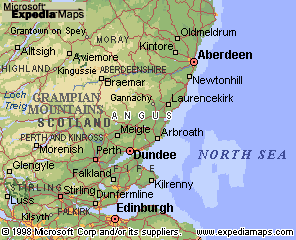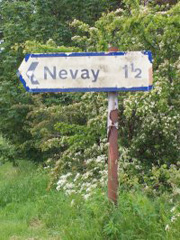|
Where did the name Navey come from?
A quick Internet search locates most of the current Naveys in the United States, Canada and the British Isles. A search on the Latter-day Saints genealogy site finds the earliest Naveys living mostly in the Angus District, Scotland, in Dundee, Fife and Midlothian. A number of Naveys are found in 19th-century England, with one mention in Switzerland, and, by that time, quite a few in the United States.
On a visit to Dundee, Scotland, located in Angus, our kinswoman Che' Navey of the United States elicited the help the Dundee city archivist, Ian, who guided her through researching family records. She chose Dundee because the first recorded Naveys in the United States (to the best of her research ability) were in Maryland in 1737. They were John and James Navey, who were listed as farmers with about 3 dozen acres of land apiece. Angus birth records (according to the LDS Web site) indicate a John and James Navey being born in early 18th century. She assumes these are the same Naveys (probably brothers) who later show up in Maryland. The Naveys, just like today, are few and far between, making tracing easier than say, “James Johnson.”
John and James Navey are reported in the Maryland books as being farmers, Che' writes. This makes sense, because according to the Dundee archivist, Ian, Nevay and the area surrounding it was entirely agricultural (and still is). They wouldn’t have been farmers in Angus and then decided to be blacksmiths in the States.
Spelling variations, according to the Dundee city archivist, are Nevay, Neive, Neva, Neve, Neave, Nevoy and Nevy. An LDS search also finds Naves, Naveis and Nevye in the area. Interestingly, the Dundee city archivist said that Nevay and Navey are pronounced the same way.
St. Neveth, the man our name came from
Unfortunately, little is available regarding just why or what St. Neveth is a saint for. However, the church of Nevay took his name for the church there, as did the town and family. And it also appears the early residents of Nevay were Catholics, according to Che'. This would explain the reason the lands were taken from them for abetting the Stewarts' cause, also known as the Uprising. “The estate of Nevay with the Kinloch estates was forfeited for Sir James’ (Nevay) participation in the Rebellion of 1745."
"St. Neveth, a martyr, to whom the church was dedicated and from whom it received its name, was a bishop 'in the north' who was slain by the Saxons and the Picts. The bishop was buried at Nevay." — An excerpt from The Ecclesiatical Architecture of Scotland from the Earliest Christian Times to the Seventeenth Century, by MacGibbon and Ross.
Che' read in the historical accounting of Nevay that Nevays were lords and ladies, knights and senators (of the college of justice).
There also is ample information on Eassie and Nevay at this site: http://www.genuki.org.uk/big/sct/ANS/EassieNevay/index.html
Following is the excerpt from "The Surnames of Scotland":
NEVAY. Of territorial origin from Nevay, a former parish in Angus now united to Essie (Eassie). In 1219 Adam de Neveth was present at the perambulation of the bounds between the lands of the Abbey of Arbroath and the barony of Kinblethmont (RAA., I, p.162). Alexander de Neve, a Scots prisoner of war in England, had a safe conduct to return to Scotland in 1422 (Bain, IV, 914). Thomas Nevay who witnessed the transumpt of a charter in 1450 is doubtless the Thomas Nieff, chaplain in Brechin in 1453 (REB., I, 146; II, 96). Alexander Nefoy witnessed a commission of bailiary in 1511 (Panmure, II, 279), John Nevay of that Ilk served on an inquest in Angus in 1558 (Southesk, p. 721), and in 1637 another John Neway appears as a charter witness (Laing, 2209). James Nevay went to Sweden in 1579, became governor of Westmanland and Dalarne and was killed by the peasantry (Fischer III, p. 67-68). His name appears in Swedish records as Neafve and Näf, and his epitaph commences: 'Jacob Nääf, en Skottskermann af adlig ätt och börde ...' (Marryat, One Year in Sweden, I, p. 420). John Naiphe of Mathie recorded in 1597 (Fordell, p. 116). Rev. John Nevoy or Nave was accused of being the instigator of the massacre at the garrison of Dunaverty in 1647 (HP., II, p. 249-253). David Nevay of that Ilk is mentioned in 1666 (Laing), and John Nevay (1792-1870), an Angus poet of some merit, is now forgotten. A poor weaver living in Forfar about 1550 claimed descent from the family of Nevoy, which ended in the direct line. Miss G.M. Nevay died in Moffat, 1940. Nauee 1661, Navay 1574, Neafve.
Here are the earliest Naveys I've turned up, all in Scotland:
— ISSOBELL NAVEY - International Genealogical Index / BI
Gender: Female Marriage: 17 MAY 1629 Alyth, Perth, Scotland
— MARGARET NAVEY - International Genealogical Index / BI
Gender: Female Birth: 22 JAN 1674, Scotland
— MART. NAVEY - International Genealogical Index / BI
Gender: Female Marriage: 09 APR 1692 Dundee, Angus, Scotland
— MARGARET NAVEY - International Genealogical Index / BI
Gender: Female Christening: 04 OCT 1696 Dundee, Angus, Scotland
— DAVID NAVEY - International Genealogical Index / BI
Gender: Male Birth: About 1725 Edinburgh, Midlothian, Scotland
— JANET NAVEY - International Genealogical Index / BI
Gender: Female Marriage: 04 NOV 1759 Saint Cuthberts, Edinburgh, Midlothian, Scotland
— ISABEL NAVEY - International Genealogical Index / BI
Gender: Female Christening: 19 AUG 1760 Kemback, Fife, Scotland
— ALEXANDER NAVEY - International Genealogical Index / BI
Gender: Male Christening: 09 MAY 1762 Kemback, Fife, Scotland
— HARRY BETHUNE NAVEY - International Genealogical Index / BI
Gender: Male Christening: 09 JUL 1769 Kemback, Fife, Scotland
— ALEXANDER NAVEY - International Genealogical Index / BI
Gender: Male Christening: 29 MAY 1794 Arbirlot, Angus, Scotland
Our kinsman Bill Brackett has done even more extensive reseach, which can be seen here:
http://freepages.genealogy.rootsweb.com/~randolph/nostalgia_html/navy/navy.html
About John Nevay
The Covenant minister John Nevay of Loudoun Kirk in Ayrshire, on the West Coast of Scotland, was banished in 1662 and died abroad. The Rev. Nevay "has found a niche among the 'Scots Worthies.' He was one of four appointed by the General Assembly of 1647 to revise and correct Rouse's versification of the Psalms of David, and he also distinguished himself by executing an elegant Latin paraphrase in verse of the Song of Solomon. He was one of the ministers who attended a special celebration of the Lord's Supper at Mauchline Muir, in June 1648, which continued for several days, and was at last dispersed by a body of troopers under the Earl of Callendar and Major General Middleton. Nevay had also acted as chaplain to David Leslie's army before the Protectorate, and is charged in Sir James Turner's memoirs as having been the chief instigator of the bloody massacre of Dunaverty, in Cantyre (Kintyre), where the whole garrison of 300 men were put to death in cold blood, and whose bones may yet be picked up on the sandbanks and on the beach near the fort."
Other links to John Nevay:
John Nevay's sermons
The Covenanters' Struggle for Unity and Truth
John Nevay and Loudoun Kirk in Ayrshire
A modern Nevay who can be found on the Internet is Heather Nevay of Glasgow. She is an artist, and you can view samples of her work at:
http://www.nevayburke.freeserve.co.uk/index.htm
What about Neave? It's pronounced "KNEE-V", according to Paul Neave, who has a Web site. Some of the names he mentions seem to be taken from the same list I cite below. Paul Neave says the name is English, meaning "nephew." He says, "The surname Neave can also be found north of the border in Scotland. For certain bearers it may share the same etymology as its English counterparts, although it is likely that Scottish bearers of the name Neave owe their origin to the old parish of Nevay in Angus." His site is:
http://www.neave.com/genealogy/
The background of this page is the Angus District plaid. The photo is by Che' Navey.
|
|

